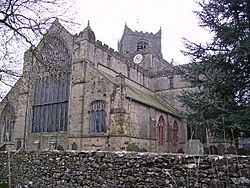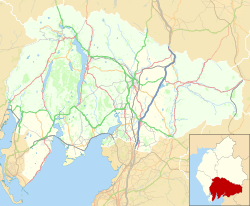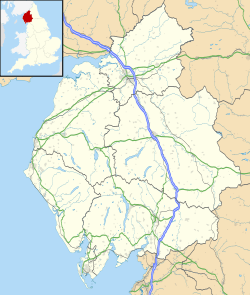Cartmel Priory facts for kids

Cartmel Priory Church
|
|
| Monastery information | |
|---|---|
| Full name | Cartmel Priory |
| Other names | St Mary the Virgin & St Michael |
| Order | Augustinian |
| Established | 1190 |
| Disestablished | 1536 |
| Diocese | Carlisle |
| People | |
| Founder(s) | William Marshal, 1st Earl of Pembroke |
| Site | |
| Location | Cartmel, Cumbria, England |
| Coordinates | 54°12′4″N 2°57′8″W / 54.20111°N 2.95222°W |
| Visible remains | Church still used as parish church, gatehouse nearby. |
| Public access | Yes |
Cartmel Priory is a very old church located in Cartmel, Cumbria, England. It has been a parish church for the local community for many years.
Contents
The Priory's Beginnings
The priory was started in 1190 by a powerful person named William Marshal. He wanted it to be a home for a group of Augustinian monks called Canons Regular. The priory was dedicated to Saint Mary the Virgin and Saint Michael.
To help the new priory, William Marshal gave it all the land in the Cartmel area. The first monks, a prior and twelve canons, came from Bradenstoke Priory in Wiltshire to live there.
Changes in the 1300s
Between 1327 and 1347, a special chapel was added to the church. It had four beautiful windows with fancy stone designs called tracery. Lord Harrington paid for this chapel, and his tomb is still inside the building. The gatehouse, which is the only other old building left from the medieval priory, was built around 1330 to 1340.
Building Work in the 1400s and 1500s
In the 1400s, a lot of repair work was done on the church. This was partly because of damage, possibly from natural causes, in the northern part. The old, narrow windows at the east end were replaced with one huge stained-glass window. Special seats called misericords were put in the choir area.
The church's tower was also made taller. What's really unique is that the top part of the tower sits at a 45-degree angle to its base. This is thought to be the only tower like it in England. Work on the building continued until the 1500s, when the choir screen was built.
The 25 misericords date back to 1440 and are very well made. They include carvings of the Green Man, which is a face with leaves growing out of it.
The Priory Closes Down
In 1536, during the Dissolution of the Monasteries, the priory was closed down. This happened when King Henry VIII decided to close many monasteries in England. At that time, there were ten monks living at Cartmel Priory.
For a short time, the priory was reopened because of a protest called the Pilgrimage of Grace. However, when the protest failed, the priory was closed again. Some of the monks and villagers who supported them faced harsh consequences.
The priory used to be responsible for guiding people safely across the dangerous Cartmel Sands. After it closed, this job was given to the Duchy of Lancaster. Thomas Hogeson became the first official guide to the sands in 1548.
Cartmel as a Parish Church
When the monasteries were closed, the king's officials usually ordered all the buildings to be torn down. The materials were then sold for the king's profit. This would have meant Cartmel Priory church would also be destroyed.
However, the villagers of Cartmel asked to keep the church. This was because William Marshal, the founder, had given an altar inside the church to the village. He had also provided a priest for them. Since it was their only place of worship, their request was granted, and the church was saved.
The 1600s at the Church
Even though the villagers could keep the church, the lead from the roof of the nave (the main part of the church) was taken away. Until 1618, the villagers had to worship in the choir area because the nave had no roof. Then, a wealthy landowner named George Preston paid a lot of money to have the roof fixed.
In 1643, some Roundhead soldiers stayed in the village and even kept their horses inside the church. You can still see bullet holes from this time in the southwest door of the nave. The nave was also used as a prison for a while, and later as a grammar school between 1624 and 1790.
Restorations in the 1800s and 1900s
By 1830, the church needed repairs again. It went through a restoration that some people thought was "more enthusiastic than sympathetic," meaning it might have changed too much of the original look. In 1850, a new ceiling was put in the central part of the church.
Another big restoration happened in 1867, led by E. G. Paley. During this work:
- Old seats and galleries were removed.
- New oak benches were installed.
- Plaster and whitewash were taken off the walls, pillars, and arches.
- The old wooden roof, which had been hidden, was uncovered and fixed.
- All the windows got new glass.
- A new stone font, pulpit, and reading desk were added.
- A new organ was put in the choir.
In 1923, the gatehouse became a museum. It was used for exhibitions and meetings. In 1946, it was given to the National Trust, who still manage it as the "Cartmel Priory Gatehouse" today.
The church is an active Anglican parish church. It is part of the deanery of Windermere and the diocese of Carlisle. Cartmel Priory is a very important historical building and is listed as a Grade I listed building.
The Church Organ
The pipe organ was first put in the church in 1867 by F. Jardine of Manchester. The organ has been rebuilt twice since then, in 1969 and 2005, to keep it in good working order.
Church Bells
The church tower has a set of 6 bells. Four of these bells are new, made in 1987. The other two bells are older, from 1932, and were combined with four very old bells from the 1600s and 1700s to make the current set of six.
People Buried at the Priory
Some important people are buried at Cartmel Priory, including:
- John Harington, 1st Baron Harington
- John Harington, 2nd Baron Harington
Images for kids
-
The "Green Man" misericord in the Choir








